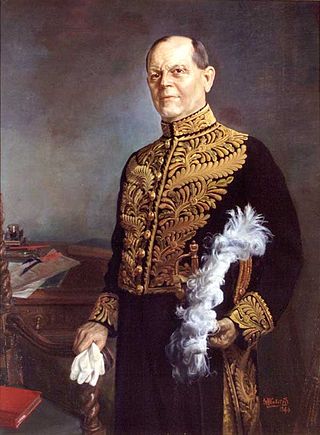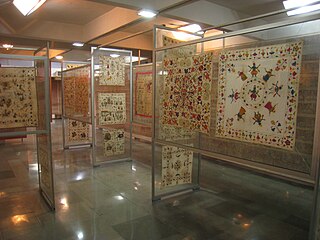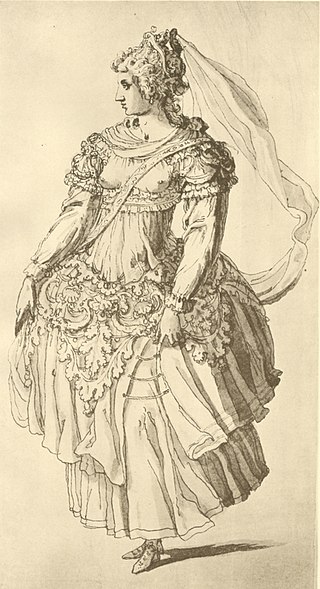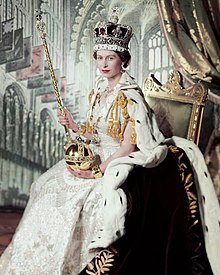
Sir Norman Bishop Hartnell was a leading British fashion designer, best known for his work for the ladies of the royal family. Hartnell gained the Royal Warrant as Dressmaker to Queen Elizabeth in 1940, and Royal Warrant as Dressmaker to Queen Elizabeth II in 1957. Princess Beatrice also wore a dress designed for Queen Elizabeth II by Hartnell for her wedding in 2020.

Korean embroidery techniques and artifacts have a long history, but there is the most evidence from the Joseon Dynasty, after the 14th century in Korea. This article talks about the history, styles, preservation, artists, and examples of screens, costumes, and domestic wares of this exacting and beautiful art form.

Armenian needlelace is a pure form of needle lace made using only a needle, thread and pair of scissors.

Fashion in the period 1550–1600 in European clothing was characterized by increased opulence. Contrasting fabrics, slashes, embroidery, applied trims, and other forms of surface ornamentation remained prominent. The wide silhouette, conical for women with breadth at the hips and broadly square for men with width at the shoulders had reached its peak in the 1530s, and by mid-century a tall, narrow line with a V-lined waist was back in fashion. Sleeves and women's skirts then began to widen again, with emphasis at the shoulder that would continue into the next century. The characteristic garment of the period was the ruff, which began as a modest ruffle attached to the neckband of a shirt or smock and grew into a separate garment of fine linen, trimmed with lace, cutwork or embroidery, and shaped into crisp, precise folds with starch and heated irons.

Court uniform and dress were required to be worn by those in attendance at the royal court in the 19th and early 20th centuries.

Embroidery in India includes dozens of embroidery styles that vary by region and clothing styles. Designs in Indian embroidery are formed on the basis of the texture and the design of the fabric and the stitch. The dot and the alternate dot, the circle, the square, the triangle, and permutations and combinations of these constitute the design.

Goldwork is the art of embroidery using metal threads. It is particularly prized for the way light plays on it. The term "goldwork" is used even when the threads are imitation gold, silver, or copper. The metal wires used to make the threads have never been entirely gold; they have always been gold-coated silver or cheaper metals, and even then the "gold" often contains a very low percent of real gold. Most metal threads are available in silver and sometimes copper as well as gold; some are available in colors as well.

English embroidery includes embroidery worked in England or by English people abroad from Anglo-Saxon times to the present day. The oldest surviving English embroideries include items from the early 10th century preserved in Durham Cathedral and the 11th century Bayeux Tapestry, if it was worked in England. The professional workshops of Medieval England created rich embroidery in metal thread and silk for ecclesiastical and secular uses. This style was called Opus Anglicanum or "English work", and was famous throughout Europe.

The wedding dress of Princess Elizabeth, was worn at her wedding to Philip Mountbatten, Duke of Edinburgh on 20 November 1947 in Westminster Abbey. Given the rationing of clothing at the time, she still had to purchase the material using ration coupons. The dress was designed by Norman Hartnell. Hartnell's signature was said to be embroidery, and he enjoyed "working with soft, floating fabrics, particularly tulle and chiffon, and with plain, lustrous silks". The dress was made of Chinese silk, with a high neckline, tailored bodice and a short train. Without straps and with long sleeves, it provided a "fit and flare silhouette".

Elizabeth Handley-Seymour (1867–1948) was a London-based fashion designer and court-dressmaker operating as Madame Handley-Seymour between 1910 and 1940. She is best known for creating the wedding dress worn by Elizabeth Bowes-Lyon, the future Queen Elizabeth The Queen Mother, for her marriage to the Duke of York, the future King George VI, in 1923; and later, Queen Elizabeth's coronation gown in 1937.

Embroidery was an important art in the Islamic world from the beginning of Islam until the Industrial Revolution disrupted traditional ways of life.

Embroidered binding, also referred to as needlework or textile binding, describes a book bound in cloth and decorated with a design on one or both covers and sometimes the spine. The binding is created for the individual book.
The wedding dress of Princess Beatrice of York worn at her wedding to Edoardo Mapelli Mozzi on 17 July 2020 was designed by the British fashion designer Norman Hartnell, who had originally created the gown for Queen Elizabeth II, the bride's grandmother, in the 1960s. The original dress was altered by the Queen's dressmaker, Angela Kelly, and British fashion designer, Stewart Parvin, who remodelled and fitted the dress for Princess Beatrice.
Bed hangings or bed curtains are fabric panels that surround a bed; they were used from medieval times through to the 19th century. Bed hangings provided privacy when the master or great bed was in a public room, such as the parlor. They also kept warmth in, and were a way of showing one's wealth. When bedrooms became more common in the mid-1700s, the use of bed hangings diminished.

The wardrobe of Mary, Queen of Scots, was described in several contemporary documents, and many records of her costume have been published.

Princess Margaret wore a cream Dior dress for her 21st birthday commemorations at Sandringham House in 1951. The off-the-shoulder silk gown was created and customised by designer Christian Dior, whom Margaret became closely associated with. The princess was captured in the piece, dubbed one of her favourite dresses, by Cecil Beaton, with the portrait becoming one of the most memorable royal photographs of the twentieth century. The dress has been cited as a part of fashion history, and has been a part of the permanent collection at the Museum of London since 1968.

Oes or owes were metallic O-shaped rings or eyelets sewn on to clothes and furnishing textiles for decorative effect. Made of gold, silver, or copper, they were used on clothing and furnishing fabrics and were smaller than modern sequins. They were made either from rings of wire or punched out of a sheet of metal.
A silkwoman was a woman in medieval, Tudor, and Stuart England who traded in silks and other fine fabrics. London silkwomen held some trading rights independently from their husbands and were exempted from some of the usual customs and laws of coverture. The trade and craft of the silkwoman was encouraged by a statute of Henry VI of England as a countermeasure to imports of silk thread, and a suitable occupation for "young gentlewomen and other apprentices".

The Stole Royal is an item of regalia used during the coronation of a British monarch, similar to the stoles worn as vestments by clergymen. It is donned after the anointing of the monarch and is worn throughout the crowning, receiving of homage and conclusion of the communion. The Stole Royal is removed, with other garments, before the procession from Westminster Abbey for which the Imperial Robe is worn.

The coronation glove is a single white glove worn on the right hand by the British monarch during part of their coronation. It is donned after they are invested with the Sovereign's Ring and remains in place during the crowning ceremony. The glove is removed prior to the taking of homage from the bishops and peers of the realm. Presenting the glove to the monarch was a right associated with the Manor of Worksop and in the past the gloves have been embroidered with the arms of the owner of that manor. In 1953 the Court of Claims ruled that the Henry Pelham-Clinton-Hope, 9th Duke of Newcastle had lost the right by passing the manor to a limited company. At the 1953 coronation the glove, now embroidered with the royal cypher, was presented to the monarch by the Chancellor of the Duchy of Lancaster.




















